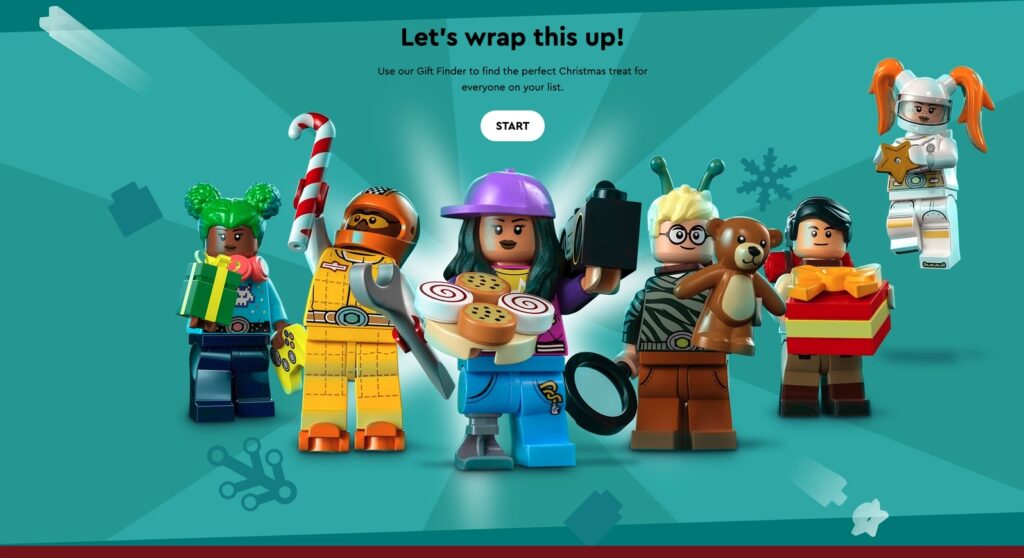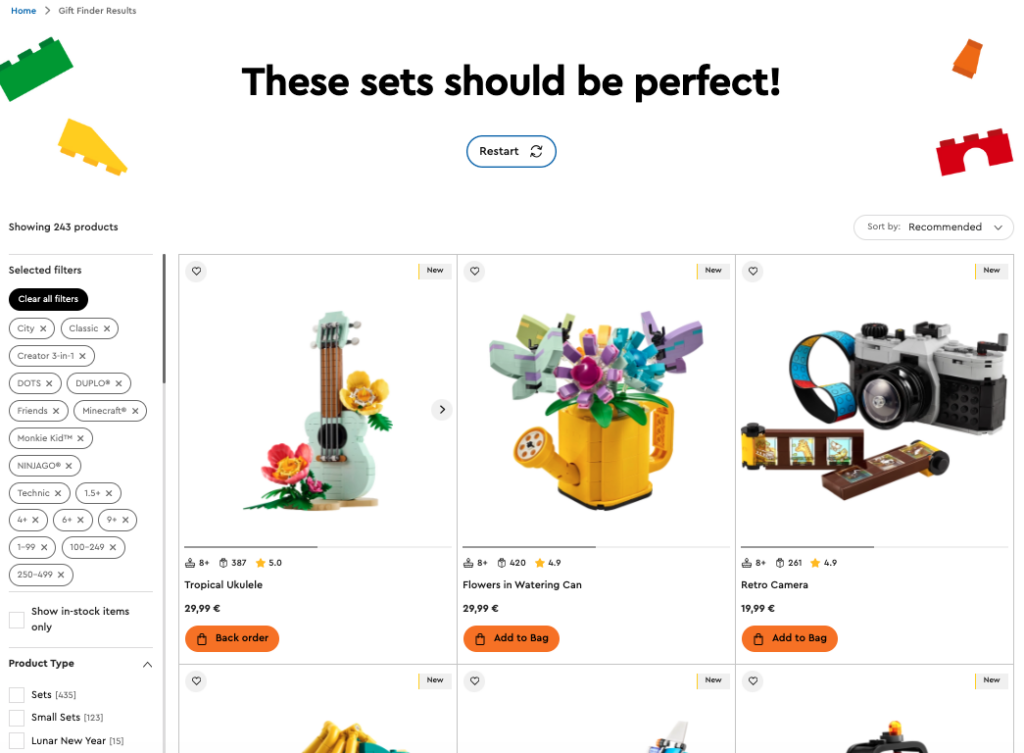Were you looking for the perfect LEGO® gift during the Christmas holidays? If so, you’ve probably come across the LEGO® Holiday Gifts Finder. While this tool seems like a great way to find the perfect gift, we found that it wasn’t very helpful. Keep reading to learn why.
Gift Finder entry point
Locating the LEGO® Holiday Gifts Finder was surprisingly challenging. It was out of sight, in the middle of a long landing page, having users passing through numerous outbound links (exceeding 30) before reaching the Gifts Finder. This location makes it difficult to find.
For those interested in accessing Holiday Gifts Finder directly, use this link.
If you’ve never visited the LEGO® website, a pop-up may appear, and the page might reload at the top. If so, simply scroll down until you locate a banner, which marks the beginning of the Gifts Finder experience.

 It is a good practice to have multiple entry points to your Shopping Guide or Product Finder. This can be achieved by placing a banner in the navigation menu, incorporating a link on the search page when there are either no results or too many, or simply embedding a link in the footer to establish the Shopping Guide as a permanent available service for customers.
It is a good practice to have multiple entry points to your Shopping Guide or Product Finder. This can be achieved by placing a banner in the navigation menu, incorporating a link on the search page when there are either no results or too many, or simply embedding a link in the footer to establish the Shopping Guide as a permanent available service for customers.
Start Your Gift Finder Journey
Embark on your quest to discover the perfect LEGO® brick gift by hitting the Start button. As you navigate through the various steps, you’ll notice that the flow is straightforward and the questions are clear and easy to answer. This is crucial for creating a successful Shopping Guide.
Let’s have a look at the steps (questions) and options (answers) used in this guide:

1. First question:
Are you looking for…
Answers:
A. Something small?
B. Something big?
 This first question helps connect the answers to the number of pieces in the set. After investigation (this information is not available to the user), if the user selects “Small”, the guide will display sets with fewer than 500 pieces, and if they choose “Big”, it will show sets with more than 500 pieces. We believe this question is valuable but not the best opening one. “Size” could have been a simple filter on the results page when products come in different sizes. Additionally, this initial question focuses on a product characteristic rather than user’s needs or preferences.
This first question helps connect the answers to the number of pieces in the set. After investigation (this information is not available to the user), if the user selects “Small”, the guide will display sets with fewer than 500 pieces, and if they choose “Big”, it will show sets with more than 500 pieces. We believe this question is valuable but not the best opening one. “Size” could have been a simple filter on the results page when products come in different sizes. Additionally, this initial question focuses on a product characteristic rather than user’s needs or preferences.
We would have started asking the user’s age as products can vary significantly depending on whether they’re intended for a 1-2 year old, a teenager, or an adult.
2. Second question:
Is this gift for…
Answers:
A. A beginner builder?
B. An advanced builder?
 This question is excellent and would have been an ideal starting point as it targets the user’s profile and the answers will provide valuable insights. If the user selects “Beginner”, they are likely not interested in products with more than 500 pieces (big sets) and can be of any age.
This question is excellent and would have been an ideal starting point as it targets the user’s profile and the answers will provide valuable insights. If the user selects “Beginner”, they are likely not interested in products with more than 500 pieces (big sets) and can be of any age.
If the user is an “Advanced” builder, they will appreciate larger sets. Additionally, if they are an advanced builder, they are unlikely to be a 1-2 year old. As a result, these products can be filtered out immediately.
3. Third question:
Do they like to…
Answers:
A. Build their own stories?
B. Play with their favourite characters?
 This is an important question. Understanding the user’s interests, particularly for LEGO® bricks, is crucial given the wide variety of themes and worlds available. Overall, it’s a good question. However, the answers are somewhat redundant and will not allow for proper product filtering. Indeed, to create or invent stories, you must have figurines and characters (it’s more enjoyable). Instead of the current options, we would have used the following answers:
This is an important question. Understanding the user’s interests, particularly for LEGO® bricks, is crucial given the wide variety of themes and worlds available. Overall, it’s a good question. However, the answers are somewhat redundant and will not allow for proper product filtering. Indeed, to create or invent stories, you must have figurines and characters (it’s more enjoyable). Instead of the current options, we would have used the following answers:
A. Build with instructions
B. Invent stories
Result Page Analysis
Now, let’s analyse the number of products recommended for each path.
Ideally, each combination should offer a limited number of products (fewer being better), with one product specifically highlighted. This would indicate that the customer’s needs have been accurately understood and the most suitable product recommended. We don’t want to overwhelm customers with a vast array of products just to showcase the sheer size of our catalog. They’re using the Gifts Finder or the Shopping Guide to find the product that matches their specific requirements, not to admire the sheer number of options.
Considering all possible paths, questions, and answers within this Gifts Finder, here’s a breakdown of the total results:
| Path | Total results |
|---|---|
| 1A-2A-3A | 243 |
| 1A-2A-3B | 112 |
| 1A-2B-3A | 112 |
| 1A-2B-3B | 122 |
| 1B-2A-3A | 90 |
| 1B-2A-3B | 175 |
| 1B-2B-3A | 69 |
| 1B-2B-3B | 178 |
 Overall, the total number of recommended products is excessively high. This is a red flag indicating that the Gifts Finder’s flow was not adequately designed.
Overall, the total number of recommended products is excessively high. This is a red flag indicating that the Gifts Finder’s flow was not adequately designed.

The screenshot above shows the result page for the 1A-2A-3A path, indicating that the customer has chosen the following options: Something small, Beginner builder, and Build their own stories.
Presenting 243 products as potential matches is overwhelming for a customer seeking a gift. While the page provides additional filters to help narrow down the results, this approach may still be too confusing and leads to choice paralysis.
 A best practice on the result page is to incorporate reassurance elements that provide tangible evidence to support the recommended products’ compatibility with the customer’s needs and selections. It will instill confidence in the chosen products.
A best practice on the result page is to incorporate reassurance elements that provide tangible evidence to support the recommended products’ compatibility with the customer’s needs and selections. It will instill confidence in the chosen products.
 Additionally, an engaging trigger, such as a limited-time promotion or an exclusive discount, could incentivise the customer to make a quick decision and purchase the recommended product.
Additionally, an engaging trigger, such as a limited-time promotion or an exclusive discount, could incentivise the customer to make a quick decision and purchase the recommended product.
In our next episode, we’ll share an enhanced LEGO® Holiday Gifts Finder using Samareo Shopping Guide’s powerful features. Stay tuned!
LEGO® is a trademark of the LEGO Group of companies which does not sponsor, authorize or endorse this site.

